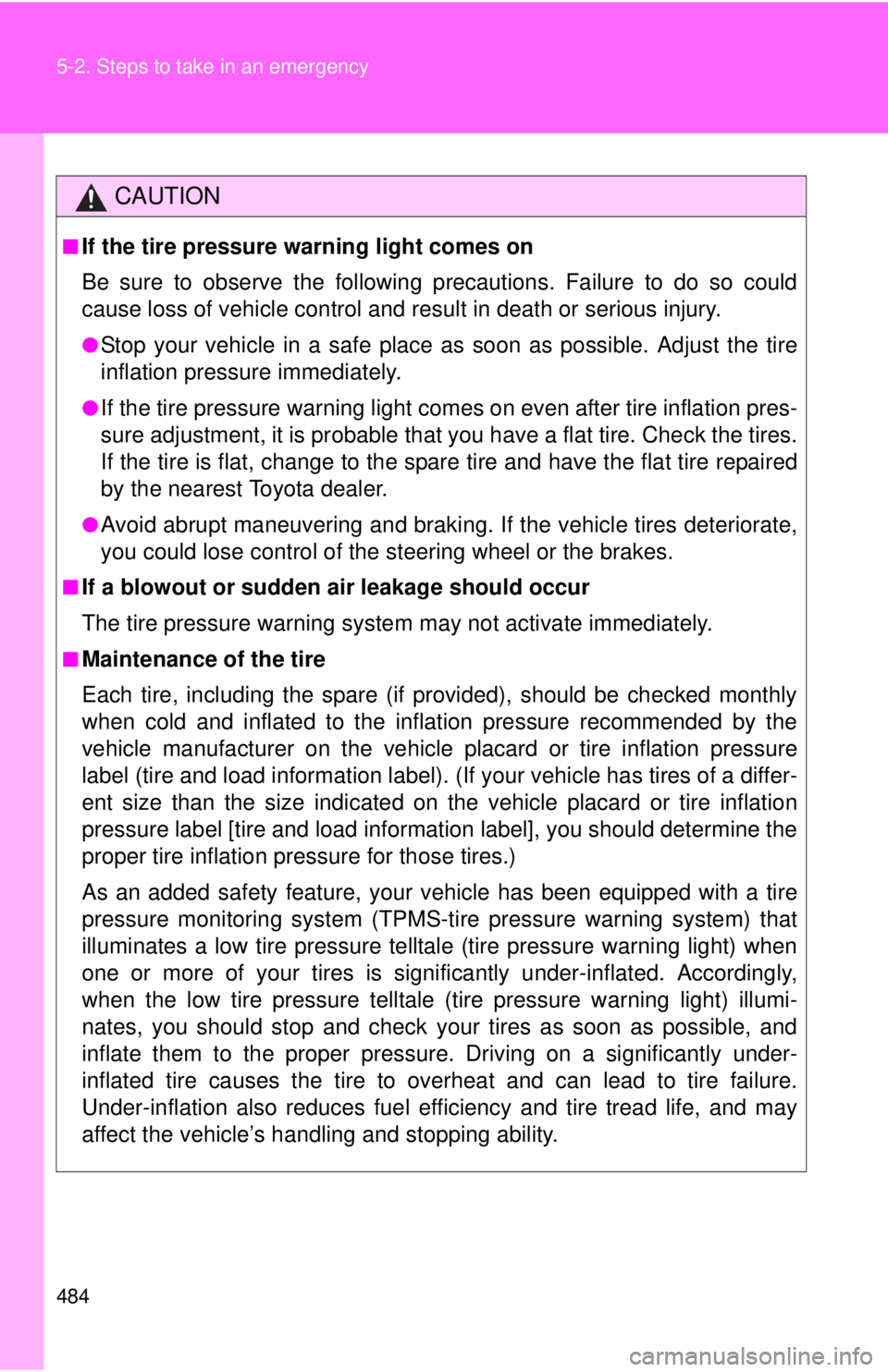Page 450 of 590
450 4-3. Do-it-yourself maintenance
*: Replace the fuse with one of the same ampere rating as the original34 AM2 30 A
IGN and GAUGE fuses, multiport
fuel injection system/sequential
multiport fuel injection system
35 AIR PMP 50 A Multiport fuel injection system/
sequential multiport fuel injection
system
36 ABS NO.2 30 A Anti-lock brake system, vehicle sta-
bility control system
37 INV 100 A Power outlets
38 ALT 120 A*
AM1, AC SKT, HEATER, FR FOG,
STOP, OBD, J/B, TOWING TAIL,
TOWING BRK and BATT CHG
fuses
140 A*
FuseAmpereCircuit
Page 451 of 590
451
4-3. Do-it-yourself maintenance
4
Maintenance and care
■
Under the instrument panel
FuseAmpereCircuit
1 IGN 15 A Multiport fuel injection system/
sequential multiport fuel injection
system, anti-lock brake system,
traction control system, vehicle sta-
bility control system, SRS airbag
system, front passenger occupant
classification system
2 GAUGE 7.5 A Meter and gauge, emergency
flashers
3 TAIL 10 A Tail lights, license plate lights, park-
ing lights, multiport fuel injection
system/sequential multiport fuel
injection system, instrument panel
light control, illuminations
4 ACC 7.5 A Shift lock system, outside rear view
mirrors, audio system, power out-
lets
5 PWR OUTLET 15 A Power outlets
6 DR LCK 20 A Door lock system
Page 452 of 590

452 4-3. Do-it-yourself maintenance
7 IG1 NO.210 AAnti-lock brake system, vehicle sta-
bility control system, stop lights,
charging system, multiport fuel
injection system/sequential multi-
port fuel injection system, air condi-
tioning system, instrument panel
light control, anti-glare inside rear
view mirror, back monitor, clutch
start cancel switch, rear differential
lock system, power outlets, tire
pressure warning system
8 BKUP LP 10 A Trailer lights (back-up lights)
9 IG1 10 AAnti-lock brake system, traction
control system, vehicle stability
control system, back-up lights, air
conditioning system, shift lock sys-
tem, audio system
10 P RR P/W 20 ARear passenger’s power window
(right side)
11 P FR P/W 20 A Front passenger’s power window
12 WSH 10 A Wipers and washer
13 D RR P/W 20 ARear passenger’s power window
(left side)
14 4WD 20 AFour-wheel drive system, rear dif-
ferential lock system
15 WIP 30 A Wipers and washer
16 D FR P/W 30 A Power windows
FuseAmpereCircuit
Page 465 of 590
When trouble arises5
465
5-1. Essential informationEmergency flashers ......... 466
If your vehicle needs to be towed ........................ 467
If you think something is wrong ............................. 474
Fuel pump shut off system ........................... 475 5-2. Steps to take in
an emergency
If a warning light turns on or a warning buzzer
sounds... ........................ 476
If you have a flat tire......... 486
If the engine will not start ................................ 501
If the shift lever cannot be shifted from P (vehicles
with an automatic
transmission) ................. 502
If you lose your keys ........ 503
If the vehicle battery is discharged ..................... 504
If your vehicle overheats ....................... 508
If the vehicle becomes stuck .............................. 511
If your vehicle has to be stopped in
an emergency ................ 513
Page 475 of 590
5
When trouble arises
475
5-1. Essential information
Fuel pump shut off system
Follow the procedure below to restart the engine after the system is
activated.Turn the engine switch to the ACC or LOCK position.
Restart the engine.
NOTICE
■Before starting the engine
Inspect the ground under the vehicle.
If you find that fuel has leaked onto the ground, the fuel system has been
damaged and is in need of repair. Do not restart the engine.
To minimize the risk of fuel leakage when the engine stalls or an air-
bag inflates upon collision, the fu el pump shut off system stops sup-
plying fuel to the engine.
Page 480 of 590
480 5-2. Steps to take in an emergency
Tire pressure warning
light
When the light comes on:
Low tire inflation pressure
such as
• Natural causes ( P. 482)
• Flat tire ( P. 486) Adjust the tire inflation
pressure to the speci-
fied level.
The light will turn off
after a few minutes.
In case the light
does not turn off
even if the tire infla-
tion pressure is
adjusted, have the
system checked by
your Toyota dealer.
• When the light stays on after blinking for 1
minute: Malfunction in
the tire pressure warning
system. ( P. 483) Have the system
checked by your
Toyota dealer.
Low fuel level warning
light
Low level of fuel. Refuel the vehicle.
Warning lightWarning light/DetailsCorrection procedure
Page 482 of 590

482 5-2. Steps to take in an emergency
■Key reminder buzzer
The buzzer indicates that the key has not been removed (with the engine
switch in the ACC or LOCK position and the driver’s door opened).
■ If the malfunction indicator lamp comes on while driving
First check the following:
● Is your vehicle low on gas?
If it is, refuel the vehicle immediately.
● Is the fuel tank cap loose?
If it is, tighten it securely.
The light will go off after taking several driving trips.
If the light does not go off even after several trips, contact your Toyota dealer
as soon as possible.
■ Front passenger detect ion sensor and passenger seat belt reminder
If luggage or other load is placed on the front passenger seat, depending on
its weight, the reminder light to flash and buzzer to sound.
■
When the tire pressure warning light comes on
Check the tire inflation pressure and adjust to the appropriate level.
Pushing the tire pressure warning reset switch does not turn off the tire
pressure warning light.
■The tire pressure warning light ma y turn on due to natural causes
The tire pressure warning light may turn on due to natural causes such
as natural air leaks or tire inflation pressure changes caused by temper-
ature. In this case, adjusting the ti re inflation pressure will turn off the
warning light (after a few minutes).
■When a tire is replaced with a spare tire
The temporary spare tire is not equipped with the tire pressure warning
valve and transmitter. If a tire goes flat, the tire pressure warning light will
not turn off even though the flat tire is replaced with the temporary spare
tire. Replace the temporary spare tire with the repaired tire and adjust
the proper tire inflatio n pressure. The tire pres sure warning light will turn
off after a few minutes.
Page 484 of 590

484 5-2. Steps to take in an emergency
CAUTION
■If the tire pressure warning light comes on
Be sure to observe the following precautions. Failure to do so could
cause loss of vehicle control and re sult in death or serious injury.
●Stop your vehicle in a safe place as soon as possible. Adjust the tire
inflation pressure immediately.
●If the tire pressure warning light comes on even after tire inflation pres-
sure adjustment, it is pr obable that you have a flat tire. Check the tires.
If the tire is flat, change to the spare tire and have the flat tire repaired
by the nearest Toyota dealer.
●Avoid abrupt maneuvering and braking. If the vehicle tires deteriorate,
you could lose control of the steering wheel or the brakes.
■If a blowout or sudden air leakage should occur
The tire pressure warning syste m may not activate immediately.
■Maintenance of the tire
Each tire, including the spare (if provided), should be checked monthly
when cold and inflated to the inflation pressure recommended by the
vehicle manufacturer on the vehicle placard or tire inflation pressure
label (tire and load information label). (If your vehicle has tires of a differ-
ent size than the size indicated on the vehicle placard or tire inflation
pressure label [tire and load information label], you should determine the
proper tire inflation pr essure for those tires.)
As an added safety feature, your vehicle has been equipped with a tire
pressure monitoring system (TPMS-ti re pressure warning system) that
illuminates a low tire pressure telltal e (tire pressure warning light) when
one or more of your tires is significantly under-inflated. Accordingly,
when the low tire pressu re telltale (tire pressure warning light) illumi-
nates, you should stop and check your tires as soon as possible, and
inflate them to the proper pressure. Driving on a significantly under-
inflated tire causes the tire to overheat and can lead to tire failure.
Under-inflation also reduces fuel effi ciency and tire tread life, and may
affect the vehicle’s handling and stopping ability.